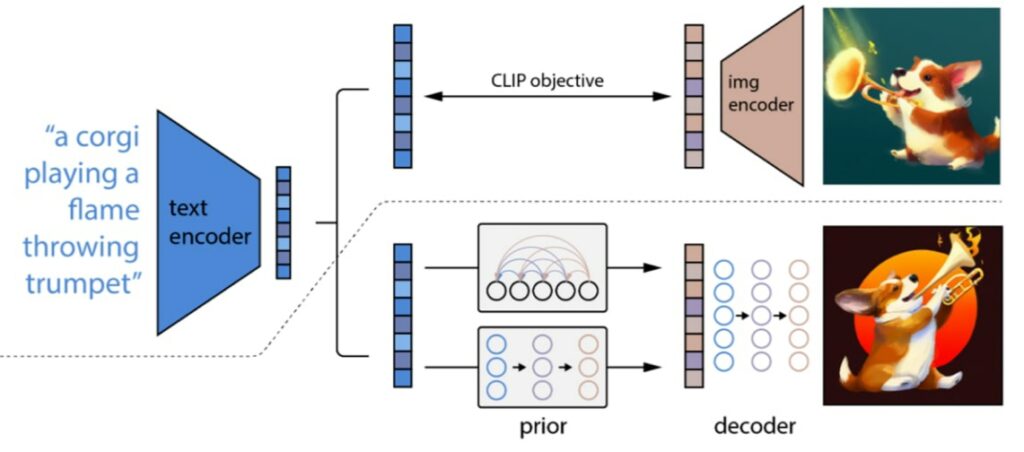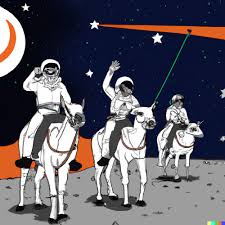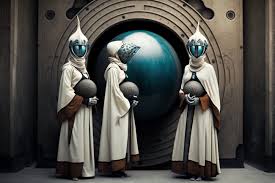
Definition of AI Art Generator
An AI art generator is a computer software that employs artificial intelligence (AI) to produce artistic creations. These AI generators generally rely on machine learning algorithms and deep neural networks to study a vast collection of existing art. They then utilize this knowledge to generate fresh artwork that resembles the examples they’ve learned from.
AI art generator have the capability to generate diverse forms of art, such as paintings, drawings, sculptures, and even music. Some well-known AI art generators are:
Midjourney: Midjourney AI is an innovative application of generative artificial intelligence (AI) that uses text prompts to generate images. It extensively employs machine learning techniques, specifically large language and diffusion models to create unique and stunning output images.. The outcomes produced by Midjourney AI are often astonishing, consistently impressive, and exhibit a high level of creativity.
DALL-E 2: This generator can create images from text descriptions. For example, you could type in “a painting of a cat riding a unicycle” and DALL-E 2 would generate an image of a cat riding a unicycle.
Bottleneck: This generator can create images from existing images. For example, you could upload a photo of a cat and Bottleneck would generate a new image of the cat with a different style or color palette.
Magenta: This generator can create music from text descriptions. For example, you could type in “a sad piano piece” and Magenta would generate a new piece of music that is sad and sounds like it was played on a piano.
Read about caktus ai tool
Importance and growing popularity of AI-generated art
AI-generated art is gaining significant importance and popularity in recent times. The use of artificial intelligence (AI) to create art opens up new possibilities and challenges traditional notions of creativity. Here are some reasons why AI-generated art is gaining traction:
- Exploration of New Aesthetics: AI-generated art pushes the boundaries of what is considered aesthetically pleasing. It can produce unique and unconventional artistic styles that may not have been explored by human artists. This allows for the discovery of fresh and exciting artistic expressions.
- Democratization of Art: AI-generated art has the potential to democratize the art world. It provides a platform for anyone with access to AI tools to create art, regardless of their artistic training or background. This inclusivity expands the diversity and range of artistic voices in the creative landscape.
- Inspiration and Collaboration: AI-generated art can inspire human artists by offering new perspectives and ideas. It can serve as a tool for collaboration, where artists work alongside AI systems to create innovative and hybrid artworks. This collaboration between human creativity and AI algorithms can lead to novel artistic possibilities.
- Efficiency and Productivity: AI art generators can quickly produce a large volume of artwork. They can analyze vast datasets and generate art at a rapid pace, saving time and effort for artists. This efficiency can be particularly useful in commercial applications where fast turnaround times are required.
- Technological Advancements: The growing popularity of AI-generated art reflects the rapid advancements in AI technology. As AI algorithms improve, so does the quality and sophistication of the generated art. This creates a sense of excitement and curiosity among artists, researchers, and the general public.
Overall, the importance and growing popularity of AI Art Generator lie in its ability to challenge traditional artistic practices, democratize creativity, inspire collaboration, improve efficiency, and showcase the potential of AI technology in the creative domain.
How AI Art Generators work?
AI art generators make new artwork by using special computer programs known as Machine Learning. These programs learn from a big collection of existing art, like paintings and drawings. They learn what makes each piece of art unique and special. Once they’ve learned enough, they can use that knowledge to create brand new art that looks similar to the examples they’ve seen before.

Here’s a simplified explanation of how they work:
- Training with Existing Art: AI art generators start by using a large dataset of existing art, which can include various types such as paintings, drawings, sculptures, or even music. This dataset is used to train the AI algorithm.
- Learning Patterns and Features: The AI algorithm analyzes the dataset to identify patterns, styles, and other unique features present in the art. It learns what makes each piece of art distinctive.
- Generating New Art: Once the AI algorithm has learned from the dataset, it can generate new art based on that knowledge. It uses the patterns and features it has learned to create artwork that is similar to the examples it was trained on.
- Creative Variation: AI art generators often have settings or parameters that allow users to adjust certain aspects of the generated art. This can include modifying the style, color palette, or level of abstraction, enabling users to have some control over the output.
- Iterative Improvement: AI art generators can continuously improve their output by incorporating feedback. For example, if users provide feedback on the generated art, the algorithm can learn from it and adjust its generation process accordingly, aiming to produce more desirable results in the future.
Read about God Mode AI
Types of AI Art Generators
There are two main types of AI art generators:
Generative adversarial networks (GANs):
GANs are a type of machine learning algorithm that works by creating two competing neural networks. One network, the generator, is responsible for creating new art. The other network, the discriminator, is responsible for determining whether the art is real or fake. The generator and discriminator networks are constantly competing with each other, which helps the generator to create more realistic and convincing art.
Neural Style Transfer:
Neural Style Transfer is a technique that uses deep neural networks to transfer the style of one image to another image. For example, you could use Neural Style Transfer to transfer the style of a painting to a photograph.
Benefits and Advantages of AI Art Generators
These innovative AI art generator tools offer numerous benefits and advantages to artists, enthusiasts, and even those without any artistic background. Let’s explore the advantages of AI art generators across four key areas: creativity and inspiration, efficiency and productivity, accessibility, and experimental possibilities.
A. Creativity and Inspiration:
Augmenting Human Artistic Abilities AI art generators act as powerful tools to augment human creativity and inspiration. They can assist artists in generating unique ideas and expanding their artistic horizons. By analyzing vast amounts of data and learning from various art styles, AI algorithms can suggest new concepts, compositions, and color palettes, sparking fresh perspectives. Artists can leverage these suggestions to explore uncharted territories and break free from creative blocks. AI-powered tools provide a collaborative environment where humans and machines work together, stimulating artistic imagination in unprecedented ways.
B. Efficiency and Productivity:
Saving Time and Effort for Artists Traditionally, creating art requires extensive time, effort, and experimentation. AI art generators significantly streamline the creative process, saving artists valuable time and energy. These tools can rapidly generate initial sketches, compositions, or even complete artworks based on input parameters and desired styles. Artists can focus more on refining and adding their personal touch to these generated outputs, accelerating the overall workflow. Moreover, AI algorithms can assist in automating repetitive tasks such as rendering, scaling, or applying complex effects, allowing artists to allocate more time to the core artistic aspects.
C. Accessibility:
Enabling Non-Artists to Create and Appreciate Art AI art generators have made art creation and appreciation more accessible to a wider audience, including those without prior artistic skills. These tools offer user-friendly interfaces and intuitive controls that simplify the art-making process. Non-artists can experiment, express themselves, and create visually appealing artworks without the need for extensive training or technical expertise. AI art generators also facilitate art appreciation by enabling individuals to explore and understand various artistic styles. Users can generate AI-based artworks resembling the works of renowned artists, granting them an opportunity to delve into different art movements and gain a deeper appreciation for the artistic world.
D. Experimental Possibilities:
Pushing Artistic Boundaries AI art generators encourage experimentation and push the boundaries of traditional art forms. Artists can leverage these tools to explore new artistic techniques, blending and merging styles, or even creating entirely novel art forms. AI algorithms can generate imaginative compositions by combining elements from different sources, creating unique and thought-provoking visuals. Additionally, AI art generators can simulate various traditional and digital art mediums, allowing artists to experiment with techniques that may have been previously inaccessible. The fusion of human creativity and AI capabilities opens up a realm of endless artistic possibilities.
In conclusion, AI art generators offer a myriad of benefits and advantages that enhance the artistic process for creators and enthusiasts alike.
By augmenting human creativity and inspiration, saving time and effort, enabling non-artists to engage in art creation, and pushing the boundaries of experimentation, AI art generators are transforming the art world.
These tools serve as catalysts for innovation, fostering collaboration between humans and machines and propelling art into unexplored realms. As AI technology continues to evolve, we can expect even more exciting developments in the realm of AI-generated art, revolutionizing the way we create, appreciate, and experience artistic expressions.
Read about Tome AI
Sad Part of AI Art Generator
A. Attribution and Ownership:
Addressing Issues of Authorship and Copyright One of the key disadvantages of AI art generators is the challenge it poses in determining attribution and ownership. AI-generated artworks blur the lines of authorship, as the creative input comes from both the artist and the AI algorithm. This raises questions about who should be credited as the creator and who holds the rights to the artwork.
Additionally, issues surrounding copyright arise when AI-generated art resembles existing works or incorporates copyrighted elements. Resolving these concerns requires clear guidelines and legal frameworks that address the unique nature of AI-generated art.
B. Authenticity and Originality:
Evaluating the Value of AI-Generated Art The authenticity and originality of AI-generated art can be subject to scrutiny. Critics argue that since AI algorithms analyze existing artworks and generate outputs based on learned patterns, the resulting art may lack true originality or genuine human expression.
Evaluating the artistic value and significance of AI-generated art becomes a subjective matter, challenging traditional notions of creativity and artistic merit. This raises questions about the lasting impact and cultural relevance of AI-generated artworks in the art world.
C. Algorithmic Bias and Cultural Implications
AI algorithms are trained on large datasets that may contain biases and reflect existing societal norms. This can inadvertently introduce algorithmic bias into AI-generated art, perpetuating existing stereotypes or excluding underrepresented perspectives. Such biases have the potential to reinforce societal inequalities and limit the diversity of artistic expressions.
It is crucial to address and mitigate algorithmic bias by ensuring diverse training data and implementing ethical guidelines for AI art generators.
D. Impact on Traditional Art Forms and Artists’ Livelihoods
The rise of AI art generators has sparked concerns regarding the impact on traditional art forms and the livelihoods of artists. As AI tools become more sophisticated, there is a fear that they may replace certain artistic practices or reduce the demand for handmade, traditional artworks.
This can have a detrimental effect on artists who rely on these forms as their primary means of income.
Additionally, the accessibility of AI-generated art to a wider audience may increase competition and further challenge the sustainability of traditional art forms. Finding a balance between AI-generated art and traditional artistic practices is essential to preserve artistic diversity and support artists’ livelihoods.
It is important to acknowledge and address these disadvantages and challenges associated with AI art generators to ensure ethical and responsible use of this technology. By understanding and actively mitigating these concerns, we can harness the potential of AI while preserving the integrity, diversity, and cultural significance of the art world.
Examples and Success Stories
of AI Art Generator projects
Here are some success stories of AI art generator projects:
DALL-E 2: DALL-E 2 was released in April 2022 and quickly became one of the most popular AI art generators. It has been used by artists, designers, and businesses to create a wide variety of art.

For example, DALL-E 2 was used by Nike to create a new line of sneakers, and it was also used by the BBC to create a series of animated shorts.
Bottleneck: Bottleneck was released in 2021 and has been used to create a wide variety of art, including portraits, landscapes, and abstract art.

It has also been used to create art for educational purposes, such as teaching people about different art styles. For example, Bottleneck was used by the Museum of Modern Art to create a series of interactive exhibits.
VQGAN+CLIP: VQGAN+CLIP was released in 2021 and has been used to create a wide variety of art, including paintings, drawings, and sculptures.

It has also been used to create art for commercial purposes, such as product designs and marketing materials. For example, VQGAN+CLIP was used by the company Airbnb to create a new logo.
Midjourney: Midjourney was released in 2022 and has quickly become one of the most popular AI art generators. It is a subscription-based service that allows users to create art by interacting with a chatbot. Midjourney has been used to create a wide variety of art, including paintings, drawings, and sculptures.

It has also been used to create art for commercial purposes, such as product designs and marketing materials.
Artbreeder: Artbreeder was released in 2018 and has been used to create a wide variety of art, including portraits, landscapes, and abstract art. It is a free-to-use service that has been used by artists, designers, and businesses.

For example, Artbreeder was used by the company Wizards of the Coast to create new card art for the Magic: The Gathering card game.
Collaborations between AI and human artists
There have been a number of collaborations between AI and human artists in recent years. These collaborations have explored the potential of AI to augment and inspire human creativity.
One of the most well-known examples of AI-human collaboration in art is the work of Mario Klingemann.
Klingemann is a German artist who has worked with AI to create a variety of artworks, including “Memories of Passersby I” and “Edmond de Belamy“. In “Memories of Passersby I”, Klingemann used AI to generate a never-ending, never-repeating stream of portraits of non-existing people. In “Edmond de Belamy”, Klingemann used AI to create a portrait that was auctioned at Sotheby’s for $432,000.
Criticisms and Limitations
Criticisms and Limitations of AI Art Generators
A. Lack of Emotional Depth and Artistic Intent:
One common criticism of AI art generators is their perceived lack of emotional depth and artistic intent. While these algorithms can mimic the styles and techniques of various artists, they often struggle to convey the same level of emotion, meaning, and personal expression as human-created art. AI-generated art can sometimes feel algorithmic and sterile, lacking the nuanced and subjective aspects that make art deeply resonant and thought-provoking.
B. Overreliance on Existing Data and Styles:
AI art generators heavily rely on existing data and styles for their learning and generation processes. This reliance can limit the originality and creativity of the generated art. The algorithms tend to produce artworks that align closely with the training data, resulting in a lack of novelty and a tendency to replicate familiar patterns. This limitation may hinder the exploration of truly groundbreaking and innovative artistic ideas that go beyond existing artistic conventions.
C. Replicating Biases and Perpetuating Stereotypes:
AI algorithms learn from vast amounts of data, which can inadvertently contain biases and reflect existing societal norms. This poses a significant challenge when it comes to AI-generated art, as it can perpetuate stereotypes and cultural biases present in the training data. The algorithms may unintentionally reproduce discriminatory or prejudiced representations, reinforcing societal inequalities and limiting diverse perspectives in art. Addressing and mitigating algorithmic biases in AI art generators is crucial to ensure fairness, inclusivity, and a broader representation of artistic voices.
Future of AI Art Generator
The potential of AI art generation looks promising, thanks to the progress made in AI technology. With advancements in algorithms and access to extensive datasets, AI can now produce intricate and refined art forms. This advancement opens doors to previously unattainable levels of creativity, allowing for the emergence of novel and complex artistic expressions.
Here are some of the ways that AI technology is advancing and how it will impact the future of AI art generation:
- Larger datasets: AI algorithms are trained on large datasets of existing art. As these datasets become larger and more diverse, AI algorithms will be able to learn more about different art styles and techniques. This will allow them to generate more realistic and creative art.
- More powerful algorithms: AI algorithms are becoming more powerful, with the ability to process more data and generate more complex outputs. This will allow them to create art that is more detailed and nuanced.
- New techniques: AI researchers are constantly developing new techniques for AI art generation. These techniques will allow AI algorithms to create art in new and innovative ways.
As AI technology continues to advance, we can expect to see even more innovative and creative AI art in the future. AI art will become more sophisticated, leading to new forms of creativity that were not possible before. AI art will also become more accessible to everyone, as AI art generators become more affordable and user-friendly.